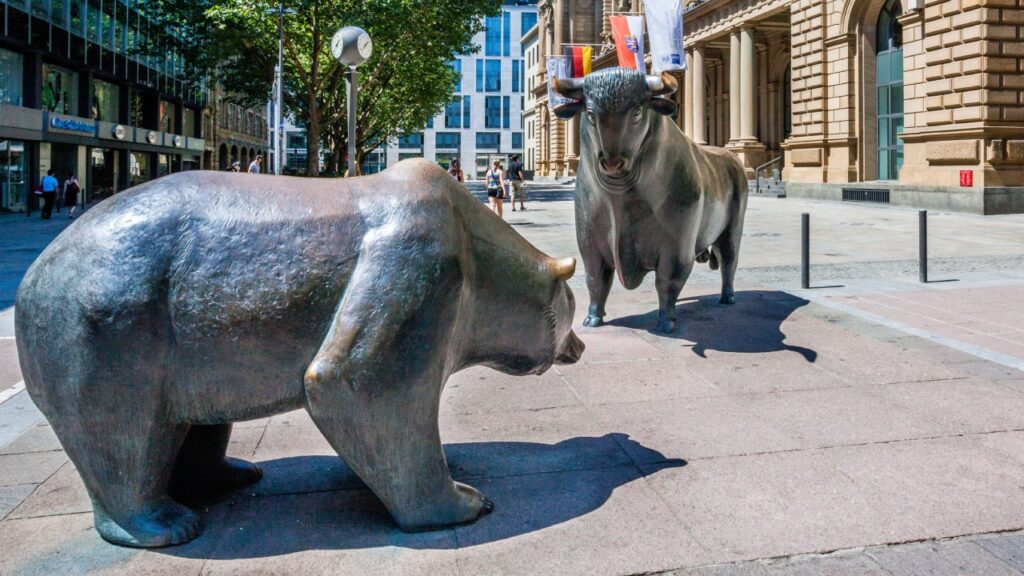Manfred Gottschalk/Getty Images
“Bear” and “bull” are two terms used to describe different parts of the market cycle, and they can tell investors a lot about what’s going on in the economy.
A bear market is a prolonged decline in stock prices. A bull market is a prolonged rise in prices.
Understanding what a bull market looks like compared to a bear market can be helpful when it comes to making informed investment decisions. Here’s a breakdown of what each type of market entails, how bull and bear markets work, and how to invest during both.
What is a bull market?
A bull market is the opposite of a bear market and occurs when asset prices rise significantly over a long period of time, commonly defined as a 20% or more increase from their most recent low. A bull market can also refer to a price spike in a specific market.
Bull markets typically happen alongside a growing or strong economy, a solid gross domestic product (GDP), rising corporate profits that lift stock prices, and lower unemployment. In the same way a bear market can shake investor confidence, a bull market can boost investor confidence, thus driving returns higher too.
Bull markets tend to be longer than bear markets, lasting an average of five years. Over the years, the stock market has seen many bull runs, which happen on average every six years. The longest bull market to date started in March 2009 and ran through February 2020. The S&P 500 has had 13 bull markets since 1946.
What is a bear market?
There isn’t a hard-and-fast rule, but some analysts describe a bear market as a decline of 20% or more off recent highs in the market across a broad range of asset classes. A bear market might also be confined to an asset class.
Bear markets tend to occur before an economic downturn and may signal a recession. Some notable bear markets include the Great Depression, the dot-com bubble, the Great Recession and as the pandemic started in February 2020, which is one of the shortest bear markets at 33 days.
Bear markets can be caused by a slowing or sluggish economy, high inflation, rising interest rates, geopolitical instability, substantial shifts in the economy and other factors that impact investor sentiment and create uncertainty.
Bear markets tend to be shorter than bull markets, lasting about 10 to 12 months on average in the S&P 500. There have been 13 bear markets in the S&P 500 since 1946, an average of one every six years.
Bull market vs. bear market
It can be helpful to think of bull and bear markets as generally opposites to one another, but here’s a side-by-side look at what each type entails.
| Bull market | Bear market | |
| Performance | Asset prices rising | Asset prices falling |
| Economic indicators | • Expanding GDP • Rising investor confidence • Declining unemployment |
• Shrinking GDP • Falling investor confidence • Rising unemployment |
| Average duration* | 5.3 years (since 1943) | 12 months (since 1946) |
| Frequency* | 6.1 years (since 1943) | 5.8 years (since 1946) |
| Average return* | 169.5 percent (for bull markets between 1943 and 2021) | -33.6 percent (for bear markets between 1945 and 2021) |
How to invest in a bull or bear market
Predicting bear and bull markets can be tough, even impossible. By the time investors recognize a bear or bull market is happening, it’s often too late to shift strategies. That’s why it’s better to focus on long-term investing rather than trying to trade your way out of a bear market or into a bull market. Remember, time in the market beats timing the market almost every time.
Regardless of what the market does, consider holding low-cost index funds and using dollar-cost averaging to invest throughout the ups and downs. An index fund gives you diversified exposure to stocks and you make consistent contributions with dollar-cost averaging.
There are a few strategies to consider when investing in a bear or bull market. If you want to build a comprehensive plan, talking with a financial advisor may be helpful.
Investing in a bear market
- Fight the urge to sell: It’s tempting to sell your assets when the market drops and keeps falling, but you stand to miss the rebound if you try to time the market.
- Get defensive: Defensive funds and stocks can perform well during economic downturns by banking on sectors that stay strong, such as utilities.
- Hedge with bonds and dividend stocks: Add some diversification with bonds and dividend stocks that have a history of solid returns. Bond prices tend to move inversely to stocks and government bonds in particular become more attractive during economic downturns.
- Evaluate your investments: Rebalancing your portfolio should be part of every investor’s checklist, but especially in a bear market to ensure you’re on track with your long-term goals.
Investing in a bull market
- Hold on to sector leaders and funds: Just because the market is up doesn’t mean you have to change your entire investing strategy. Hold on to stocks that are leading sectors, such as technology and financials. If you’re looking for minimal effort and solid returns, buying an S&P 500 index fund and holding it for years (as Warren Buffett recommends) has worked well for many investors.
- Add money to the market over time: Dollar-cost averaging is a tried-and-true way to ensure that you’re consistently investing and spreading your cash across high and low asset prices.
- Keep the excitement in check: It can be exciting when your investments rise, spurring you to then invest more than you intended and potentially impacting your overall position. Instead, make a plan for how to reach your financial goals and stick with it, keeping your emotions out of the equation.
Bottom line
Whether stock prices rise in a bull market or fall in a bear market, the same investing basics hold true. Use dollar-cost averaging to your advantage; consider buying and holding low-cost index funds for the long term; and focus on time in the market, not timing the market. Building an investment plan that works for you should ultimately pay off more than trying to beat the market.
Editorial Disclaimer: All investors are advised to conduct their own independent research into investment strategies before making an investment decision. In addition, investors are advised that past investment product performance is no guarantee of future price appreciation.
Read the full article here
















